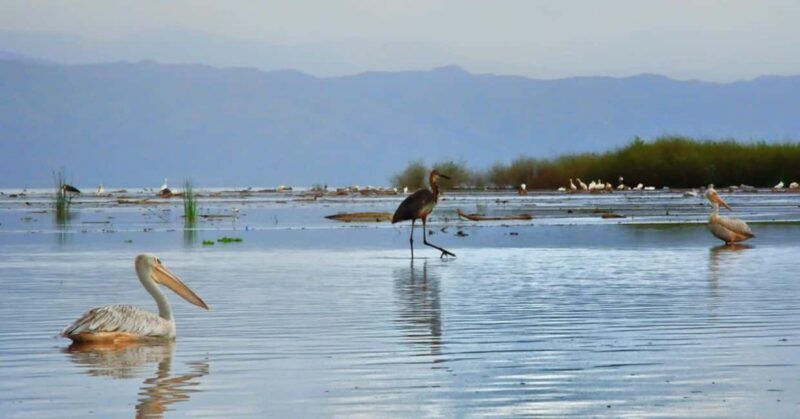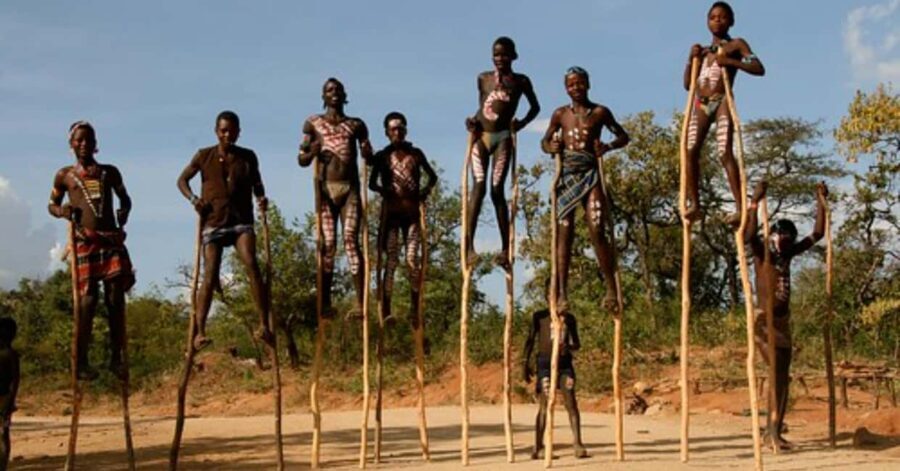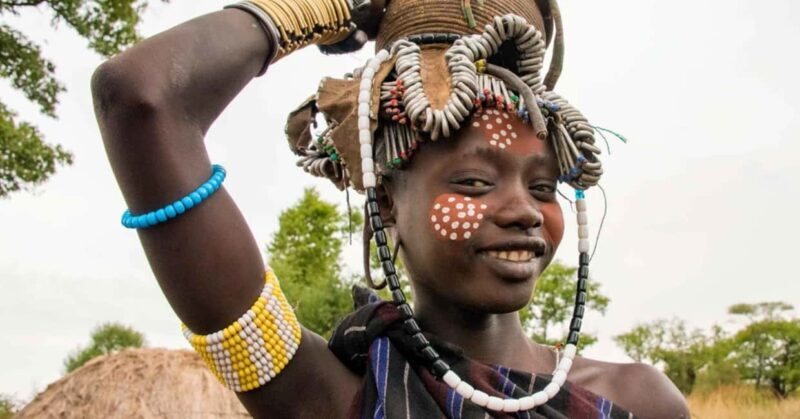Introduction

Taking a trip to Ethiopia’s Omo Valley is like opening a window into a completely different world. This 9-day tour offers a chance to see firsthand how some of Africa’s most iconic tribes live, dress, and celebrate their cultures with almost no influence from modern society.
What makes this experience stand out? We love the opportunity to visit diverse tribes like the Dorze, Hamer, and Mursi — each with their own unique customs and stories. The chance to cross the Omo River in a small boat and witness a traditional bull jumping ceremony are undeniably special moments. Plus, the tour strikes a good balance between culture and comfortable logistics.
One thing to keep in mind is the rough terrain and remote nature of some sites—this isn’t a luxury cruise through polished museums. It’s a genuine, sometimes rugged adventure. This tour works best for travelers eager to see Ethiopia’s deep-rooted traditions and who don’t mind a bit of travel discomfort for authentic experiences.
If you’re enthusiastic about cultural discovery, enjoy off-the-beaten-path travel, and want a well-organized trip that’s worth its price, this could be a perfect fit.
You can check availability for your dates here:Key Points

- Authentic cultural encounters: Visit multiple tribes including Dorze, Hamer, Dassanech, and Mursi.
- Memorable experiences: Cross the Omo River by boat and witness a traditional bull jumping ceremony.
- Comfortable but adventurous: Private transportation, guided tours, and accommodations with breakfast.
- In-depth itinerary: Explore villages, learn about their histories, and see traditional body art and dress.
- Remote yet accessible: While some sites are hard to reach, the tour manages to provide a balanced experience.
- Good value: At $2,075 per person, the tour covers all attraction fees, guides, boat trips, and more — making it a solid investment for cultural enthusiasts.
Looking for more options in Arba Minch? We've reviewed plenty of other experiences.
Exploring the Itinerary

Day 1: Arrival in Addis Ababa
Starting in Ethiopia’s bustling capital, the journey begins at Bole International Airport. Here, a guide from Essence Ethiopia Tours will meet you, ensuring your arrival is smooth. You’ll be taken to your hotel, where a bit of rest will prepare you for the adventures ahead. Even this initial contact sets a welcoming tone, with guides known for their friendly demeanor and local insight.
Day 2: From Addis Ababa to Arba Minch and the Dorze Village
A scenic drive south takes us to Arba Minch, famed for its lush highlands and lakes. The highlight here is the Dorze Village, world-famous for their towering beehive-shaped homes built from bamboo and banana leaves. We loved the chance to walk through the village with a guide explaining daily life — from their weaving skills to their clever architecture. The Dorze are known for their cool, creative homes and warm hospitality, making this a delightful first stop.
More Great Tours NearbyDay 3: Arba Minch to Turmi via Weyto and the Tsemai Tribe
Leaving behind the greenery of Arba Minch, we head towards Turmi, passing through Weyto, home of the Tsemai tribe. This part of the drive reveals Ethiopia’s diverse landscape, from highlands to semi-arid plains. Arriving in Turmi, the heart of the Hamer people, we settle into Buska Lodge, which offers a comfortable base for the upcoming cultural explorations.
Day 4: Omo River and the Dassanech Tribe
A boat trip across the Omo River brings us to Omorate, where the Dassanech tribe resides. The boat ride itself is picturesque, with views of the riverbanks and the surrounding wildlife. Once ashore, we explore the Dassanech’s traditional fishing and hunting practices, notably crocodile hunting — a practice that adds a layer of authenticity and awe. Returning to Turmi, we witness the legendary Hamer bull jumping ceremony, a rite of passage that’s both physically demanding and culturally significant.
Day 5: Exploring Kangatan and Resting in Turmi
A quieter day takes us to Nyangaton, a farming town where we see local agriculture and meet more tribespeople. It’s a chance to absorb everyday life outside the more touristy areas. Returning to Turmi, we have time to relax and reflect on the vibrant cultures encountered so far.
Day 6: The Small but Fascinating Kara Tribe
Traveling to Kara, a tiny tribe of around 3,000 people, we learn about their body painting and beautification practices. Their traditions remain deeply rooted, and the guide emphasizes their history and social customs. This intimate visit offers a more personal connection compared to larger, more commercialized sites.
Day 7: Mursi Tribe and Jinka
A highlight of the tour is the visit to Mago National Park to meet the Mursi tribe. Famous for their lip plates and colorful attire, the Mursi make for an unforgettable experience. The morning with the Mursi is often the most talked about part, with visitors describing it as “surreal but respectful.” Afterward, we continue to Jinka, where you can explore at your own pace, perhaps visiting local markets or relaxing at Jinka Resort.
Day 8: Konso and Gamole Village
A road trip to Konso offers a look at their distinctive walled villages and terraced farming. The Gamole village is especially interesting, with its well-preserved walls and traditional layout. It’s a window into a community that has maintained its identity for centuries amidst changing times. Returning to Arba Minch, we enjoy a final night at Paradise Lodge, surrounded by stunning lake views.
Day 9: Return to Addis Ababa
The tour concludes with a flight from Arba Minch back to Addis Ababa. After a quick dinner, you’re transferred to the airport, ending a journey that’s filled with rich sights, sounds, and stories from Ethiopia’s most remote and fascinating tribes.
What We Loved About This Tour

Authentic Encounters: Every stop offers genuine interactions, from watching traditional dances to hearing stories directly from tribe members. The guides are well-versed and respectful, ensuring cultural sensitivity.
Diverse Experiences: You’re not just visiting one tribe — this tour showcases multiple communities, each with their own distinct customs, dress, and traditions. It’s a comprehensive look at the region’s cultural mosaic.
Scenic and Remote Landscapes: Traveling through Ethiopia’s varied terrain is beautiful in itself — from highlands to river plains. The boat ride across the Omo River adds a quiet, contemplative element to the adventure.
Comfort and Ease: While some sites are remote, the tour’s logistics are well-organized. Private, air-conditioned transport keeps the journey comfortable, and accommodations, including the cozy Paradise Lodge, provide a good base.
Practical Considerations
Cost and Value: At $2,075 per person, this tour covers all attraction fees, guides, boat trips, and most transportation costs, which adds up if you attempted to arrange these independently. It’s a fair price for the depth of cultural exposure and convenience.
Physical Demands: Be prepared for some rough roads, walking over uneven terrain, and possible close encounters with livestock or livestock enclosures. The bull jumping ceremony, in particular, can be physically demanding.
Timing: The tour spans nine days, which might feel rushed if you’re used to longer vacations. However, it’s a well-paced itinerary that balances travel with meaningful stops.
What To Bring: Pack comfortable shoes, sunscreen, a hat, insect repellent, a camera, and plenty of water. Respectful attire is recommended when visiting traditional villages.
Summary
This 9-day tour of the Omo Valley from Addis Ababa offers a rare glimpse into some of Africa’s most unique cultures. It’s a well-rounded experience, balancing culture with comfortable travel arrangements. You’ll see traditional houses, witness age-old ceremonies, and learn about tribes that have preserved their way of life against the odds.
While the journey involves some long drives and remote sites, the rewards are a set of deeply authentic moments many travelers find unforgettable. If you’re curious about Ethiopia’s diverse ethnic tapestry and eager to explore places few travelers visit, this trip is a compelling choice.
Who Is This Tour Best For?
This experience is perfect for travelers who crave genuine cultural encounters and are comfortable with basic amenities and bumpy roads. It suits those interested in anthropology, history, or indigenous traditions, and who are ready for a bit of adventure. It’s ideal for small groups or individuals seeking a focused, organized way to see Ethiopia’s tribes without the hassle of planning every detail themselves.
It’s less suitable for pregnant women, people with back problems, or travelers with mobility issues, given the physical and logistical demands of some sites. Those looking for luxury accommodations or a more relaxed pace might find this tour a bit intense.
FAQs
Is this tour suitable for all ages?
It’s best suited for adults or older teens able to handle long drives and some rough terrain. The physically demanding aspects, like the bull jumping ceremony, might not be appropriate for very young children or those with health issues.
What is included in the price?
The cost covers all attraction fees, private English-speaking guides, boat trips on the Omo River, private transport, airport and city transfers, accommodation with breakfast, traditional coffee ceremonies, packed water, and government taxes and fees.
Are meals included?
No, meals are not included. You’ll need to arrange or purchase your own food during the trip, though the tour provides breakfast and plenty of bottled water.
Can I book domestic flights separately?
Yes, but they are not included in the package. The tour provider can assist in booking your internal flights for an extra fee.
Is this tour private or group-based?
It’s based on a private guide and vehicle, which offers a personalized experience. The size of the group depends on bookings, but it’s generally private or small group.
What should I pack?
Bring comfortable shoes, sun protection (hat, sunscreen), insect repellent, a camera, and water. Dress modestly when visiting villages to respect local customs.
Are there any restrictions or special considerations?
This tour is not suitable for pregnant women, those with back problems, or wheelchair users. Be prepared for basic amenities in some rural areas.
What’s the best time to do this tour?
The tour’s schedule isn’t specified for seasons, but typically, avoiding the rainy season (April to September) ensures better conditions and clearer sights.
In essence, this tour offers a rare, authentic glimpse into Ethiopia’s diverse tribal cultures with a careful balance of comfort and adventure. Perfect for culturally curious travelers eager to see and understand a world that’s far removed from Western norms.
You can check availability for your dates here:More 2-Day Experiences in Arba Minch
More Tours in Arba Minch
More Tour Reviews in Arba Minch
- ArbaMinch:Dorze Village ,Lake Chamo , TukTuk south ethiopia
- From Addis 4 days Omo valley
- From Arbaminch: 2-Day Tour to Dorze Village & Konso Village
- Addis Ababa: 7-Day Chebera and Maze National Parks Tour
- Ethiopia: 10-Day Omo Valley Tour from Addis Ababa
- Ethiopia: 8-Day Omo Valley and Rift Valley Lakes Tour
